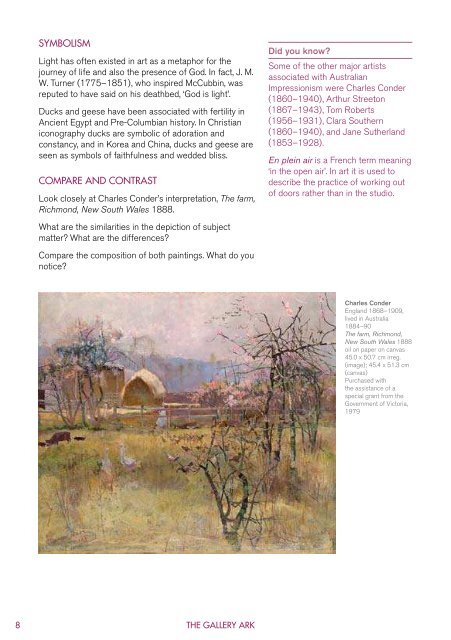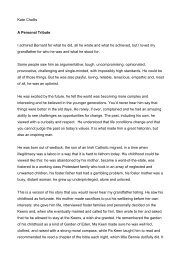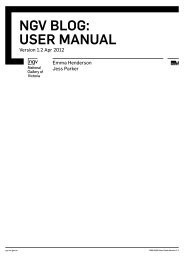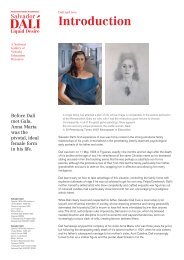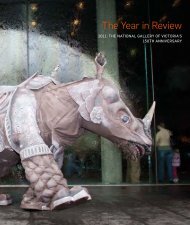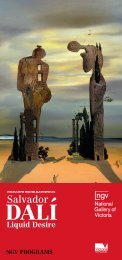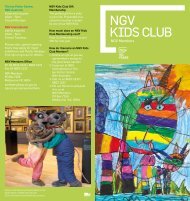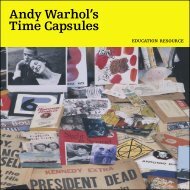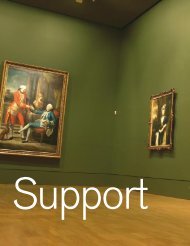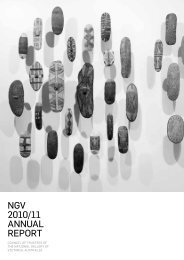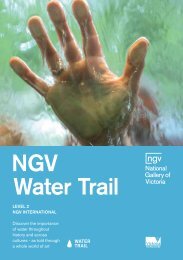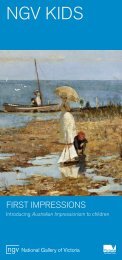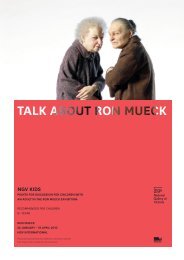EDUCATION RESOURCE - National Gallery of Victoria
EDUCATION RESOURCE - National Gallery of Victoria
EDUCATION RESOURCE - National Gallery of Victoria
You also want an ePaper? Increase the reach of your titles
YUMPU automatically turns print PDFs into web optimized ePapers that Google loves.
Symbolism<br />
Light has <strong>of</strong>ten existed in art as a metaphor for the<br />
journey <strong>of</strong> life and also the presence <strong>of</strong> God. In fact, J. M.<br />
W. Turner (1775–1851), who inspired McCubbin, was<br />
reputed to have said on his deathbed, ‘God is light’.<br />
Ducks and geese have been associated with fertility in<br />
Ancient Egypt and Pre-Columbian history. In Christian<br />
iconography ducks are symbolic <strong>of</strong> adoration and<br />
constancy, and in Korea and China, ducks and geese are<br />
seen as symbols <strong>of</strong> faithfulness and wedded bliss.<br />
Compare and contrast<br />
Look closely at Charles Conder’s interpretation, The farm,<br />
Richmond, New South Wales 1888.<br />
What are the similarities in the depiction <strong>of</strong> subject<br />
matter? What are the differences?<br />
Compare the composition <strong>of</strong> both paintings. What do you<br />
notice?<br />
Did you know?<br />
Some <strong>of</strong> the other major artists<br />
associated with Australian<br />
Impressionism were Charles Conder<br />
(1860–1940), Arthur Streeton<br />
(1867–1943), Tom Roberts<br />
(1956–1931), Clara Southern<br />
(1860–1940), and Jane Sutherland<br />
(1853–1928).<br />
En plein air is a French term meaning<br />
‘in the open air’. In art it is used to<br />
describe the practice <strong>of</strong> working out<br />
<strong>of</strong> doors rather than in the studio.<br />
Charles Conder<br />
England 1868–1909,<br />
lived in Australia<br />
1884–90<br />
The farm, Richmond,<br />
New South Wales 1888<br />
oil on paper on canvas<br />
45.0 x 50.7 cm irreg.<br />
(image); 45.4 x 51.3 cm<br />
(canvas)<br />
Purchased with<br />
the assistance <strong>of</strong> a<br />
special grant from the<br />
Government <strong>of</strong> <strong>Victoria</strong>,<br />
1979<br />
Animal Interactions<br />
Biographical reference<br />
In 1886 Conder joined the Art Society <strong>of</strong> New South<br />
Wales. In the same year he left his apprenticeship as a<br />
surveyor. Conder’s first sketching expedition to Richmond<br />
was documented in a small leather-bound book <strong>of</strong><br />
watercolour sketches inscribed with his name and<br />
address, along with the date <strong>of</strong> commencement,<br />
17 May 1887.<br />
After meeting Tom Roberts in Sydney in autumn 1888,<br />
Conder moved to Melbourne where he made a significant<br />
impact in the art world as part <strong>of</strong> the group <strong>of</strong> artists now<br />
known as the Australian Impressionists.<br />
Materials and techniques<br />
Conder was introduced to the idea <strong>of</strong> painting landscape<br />
out <strong>of</strong> doors. This was largely due to the influence <strong>of</strong><br />
Julian Ashton (1851–1942) who also painted in the<br />
Hawkesbury region, and Conder’s instructor A. J. Daplyn<br />
(1844–1926) who had both trained in London and<br />
pursued studies in Paris.<br />
Describe the light, colour and use <strong>of</strong> atmospheric effects<br />
in Conder’s painting.<br />
Issues for discussion<br />
• Identify the animals represented in the painting. Notice<br />
the broken fence. What might keep this disparate group<br />
<strong>of</strong> animals from escaping their enclosure?<br />
Symbolism<br />
Did you know?<br />
Together with Arthur Streeton, Tom<br />
Roberts and other painters, Conder<br />
spent the summers <strong>of</strong> 1888–89 and<br />
1889–90, as well as many weekends,<br />
painting near Eaglemont, Heidelberg.<br />
He was affectionately nicknamed ‘K’<br />
and exhibited with his friends in the<br />
9 by 5 Impression Exhibition held in<br />
the Buxton Galleries, Melbourne, in<br />
1889. He left Melbourne in 1890 and<br />
travelled via London to Paris where<br />
he embraced the bohemian lifestyle<br />
and met artists like Toulouse-Lautrec.<br />
The beauty and poignancy <strong>of</strong> the fragile blossom in<br />
Conder’s painting are interesting to consider. Blossom<br />
is also a favourite theme in Japanese works <strong>of</strong> art,<br />
particularly woodblock prints, and cherry blossom is<br />
Japan’s national flower. The fleeting and fragile nature <strong>of</strong><br />
their beauty suggests purity and transience. They can be<br />
seen as symbols <strong>of</strong> death and mortality. Japanese pilots<br />
during the Second World War painted blossom (sakura)<br />
on the side <strong>of</strong> their planes before embarking on a suicide<br />
mission.<br />
8 THE GALLERY ARK <strong>EDUCATION</strong> <strong>RESOURCE</strong> 9


